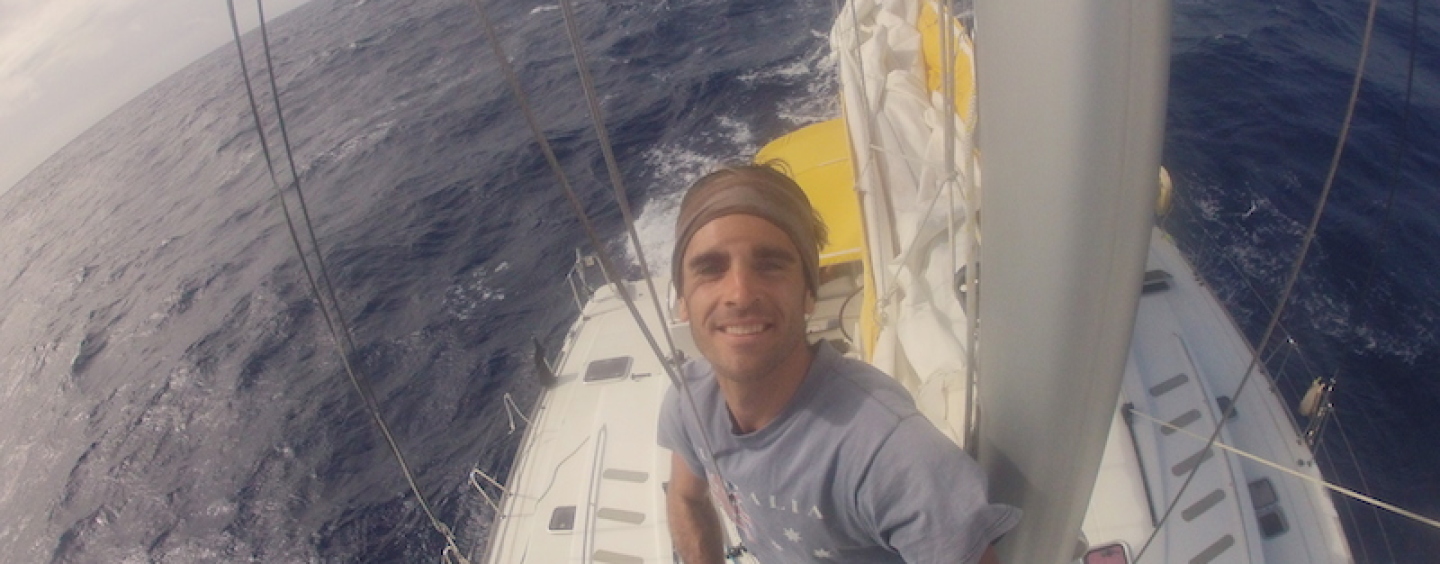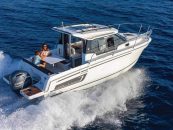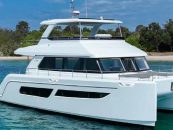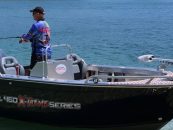I deliver boats for a living. It’s difficult to describe what life is like on a delivery voyage across the Pacific. There is a misconception that it involves sunshine, relaxed sailing and lying on the front deck reading a good book. Not likely. The 3am sail changes, inability to sleep due to losing traction with the mattress below, and the mental tiredness are closer to reality.
The mission: Relocate a Lagoon 440 from Tahiti to Australia
Greetings from the middle of the South Pacific Ocean, somewhere between Tahiti and the Kingdom of Tonga! Our commercially qualified delivery crew (myself, Les and Shane) are onboard Getaway II, a Lagoon 440, which we are relocating from Papeete, Tahiti to her new home in the Whitsundays, Australia.
The first four days after departing Taina Marina, Tahiti was great. (We departed on 3 May.) Broadreaching with 25 to 30 knots of true SE wind speed, 1st reef in the main sail, following seas, making 8 to 9 knots and surfing 10 to 12 knots down the faces of the waves. At night, sailing at 8 to 12 knots in pure darkness, with the brightest Milky Way above, and phosphorescence dancing on the water around the hull is an amazing experience.
The obvious out thing out here that slaps you in the face is that there’s an immense volume of ocean. After continuously sailing in blue water for eight days, we’ve seen one other ship, and they didn’t even answer my radio call. (But no surprise there!) You are totally alone out here on a level that’s hard to comprehend.
May 6, 2016: It’s 3am during the midnight to 4am watch (aka graveyard shift). We conduct four-hour watches between 2000hrs to 0800hrs that are staggered daily, to reduce the punishment of the graveyard shift to once per three days.
During the day, we split watch—keeping duties, repair or service items that need attention, talk weather
routing and delivery logistics, drink tea and rotate sleeping for proper fatigue management.
May 8: The boat is treating us well. Lots of little maintenance chores, but she’s solid, and sails well. I haven’t sailed her to windward yet, and I don’t fancy it, not when we have a further 3,800 miles of following seas. (Why would you?) I think my knock (defect) list is up to 63 items. And this is a great-condition boat, really. But that’s boats for you—always something to fix.
May 9: Our ETA for Tonga is tomorrow afternoon and we need fuel, food and sleep. I bet the local food tastes good!
May 10: Tied up alongside at Nuku’alofa Harbour, Tonga. Diesel arrives in 44-gallon drums, and locals eat raw, whole fish at the seafood market.
May 13: Well-rested and provisioned, we depart Tonga, clear the reef and track west. The watermaker’s circuit board failed this morning. Water rations have begun.
May 14: Someone once told me, imagine that over the lifelines lies a 30,000ft drop. If you fall, you are dead. That’s the reality. If you fall overboard during the night while on watch alone, you are very unlikely to be found.
May 17: After clearing immigration at Lautoka, Fiji, we motored south to Vuda Point Marina. The rubber of the port sail drive mount has separated from the metal plate, so engaging astern best avoided. We enter the marina on one engine and tie up alongside.
May 19: With a temporary fix in place, we depart Fiji, and snag an 80cm yellow fin tuna while navigating the outer reefs. This made great sashimi, and an ever better fish, eggplant and okra red curry. With a box of coconuts and fresh fish, it’s been high livin’!
May 21: Hello from a dark ocean at 0100hrs. The sky is full alto-cumulus, textbook blanket. But it’s still cold enough for me to have on a down jacket, wet weather jacket, longs, socks and beanie. It’s a glass out and there’s some low fog. Dropped the main this afternoon as the wind eased, now motoring, with ETA outer reef entrance of New Caledonia 0900hrs tomorrow.
May 24: We have 40 miles of inshore piloting to navigate the reef system, and will anchor outside Port Moselle, Noumea for the night as we fly the yellow Q-flag (my vessel is healthy, and I require free pratique), before we’re cleared by health, customs, immigration and bio-security checks the next morning.
May 27: It’s day 23. The solitude is nice. I don’t find it scary out here; I find the vastness of the infinite Pacific calming. It’s ironic; when sleeping at sea I feel safe, and when we’re tied up alongside a Tongan pier, I feel more on edge. It’s because people are more threatening or unpredictable. But, after it blows
60kn with 6m seas, I might temporarily change my mind on that one.
May 28: The crew are a bit run down and stuffy. It gets lonely out here. Right, I’m going to let my night eyes adjust and put them back on the road—not that there’s much traffic to dodge.
May 30: The boat is doing her job. We’ll continue to ride the tail end of this high-pressure system into
Australian waters, and should be back early June.
Signing off for now—from 22 degrees South, 158 degrees West.
Post script: Mission accomplished on schedule (4 June); arrival in Mackay, Queensland, Australia.
Voyage overview in numbers:
4,227 Nautical Miles
3 crew
5 countries
only 2 ships passed within the Pacific Ocean
a few informal bribes
3 fish
1 surf
several sleepless nights
2 storms
100 cups of tea
15 knots max boat speed
40 knots max wind speed
5 metres max swell height
0 incidents
1 great delivery voyage
Aboard a Lagoon 440
Simply put, the Lagoon 440 sails very well, considering the primary use is a comfortable cruising yacht. Sure, she’s no racing cat, but she’s not supposed to be. As do many similar cats, the 400 loves 15 to 20 knots of apparent between 50 and 90 degrees off the nose. Her sweet spot under full sail (like similar Fountaine Pajot’s) seems to be 50 to 60 degrees off the breeze with 18 knots of apparent, where she comfortably holds 7 to 9 knots of boat speed (depending on hull cleanliness, etc).
We crossed her 4,200 miles across the Pacific and she performed well. A sail drive engine mount failed (due to gear oil degrading the rubber), an aged reefing line parted (more than once), gear-shift cables were sticky and replaced, and our house batteries decided that their life was no longer worth living. However, the hull and all of the primary systems (main propulsion, steering, standing and running rigging, ground tackle, etc.) were all operated extensively and passed with beyond satisfactory marks!
By Dylan Kuipersmith, owner and skipper of Deliver My Yachts, a professional yacht delivery service



























